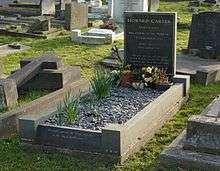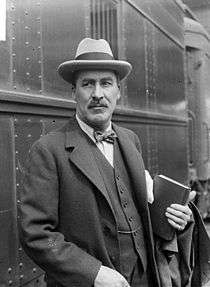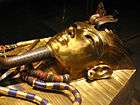Howard Carter
| Howard Carter | |
|---|---|
|
Howard Carter | |
| Born |
9 May 1874 Kensington, London, England, United Kingdom |
| Died |
2 March 1939 (aged 64) Kensington, London, England, UK |
| Nationality | English |
| Fields | Archaeology and Egyptology |
| Known for | Discovery of the tomb of Tutankhamun |
Howard Carter (9 May 1874 – 2 March 1939) was an English archaeologist and Egyptologist who became world-famous after discovering the intact tomb (designated KV62) of the 18th Dynasty Pharaoh, Tutankhamun (colloquially known as "King Tut" and "the boy king") in November 1922.
Early life
Howard Carter was born in Kensington on 9 May 1874, the son of Samuel Carter, an artist, and Martha Joyce Carter (née Sands). His father trained and developed Howard's artistic talents.
Howard Carter spent much of his childhood with relatives in the Norfolk market town of Swaffham, the birthplace of both his parents.[1][2] Nearby was the mansion of the Amherst family, Didlington Hall, containing a magnificent collection of Egyptian antiques, which sparked Carter's interest in that subject. In 1891 the Egypt Exploration Fund (EEF), on the prompting of Mary Cecil, sent Carter to assist an Amherst family friend, Percy Newberry, in the excavation and recording of Middle Kingdom tombs at Beni Hasan.
Although only 17, Carter was innovative in improving the methods of copying tomb decoration. In 1892, he worked under the tutelage of Flinders Petrie for one season at Amarna, the capital founded by the pharaoh Akhenaten. From 1894 to 1899, he worked with Édouard Naville at Deir el-Bahari, where he recorded the wall reliefs in the temple of Hatshepsut.
In 1899, Carter was appointed to the position of Chief Inspector of the Egyptian Antiquities Service (EAS). He supervised a number of excavations at Thebes (now known as Luxor). In 1904, he was transferred to the Inspectorate of Lower Egypt. Carter was praised for his improvements in the protection of, and accessibility to, existing excavation sites,[3] and his development of a grid-block system for searching for tombs. The Antiquities Service also provided funding for Carter to head his own excavation projects and during this period Carter discovered the Tombs of Thutmose I and Thutmose III, although both tombs had been robbed of treasures long before.[4]
Carter resigned from the Antiquities Service in 1905 after a formal inquiry into what became known as the Saqqara Affair, a noisy confrontation between Egyptian site guards and a group of French tourists. Carter sided with the Egyptian personnel.[5]
Tutankhamun's tomb

In 1907, after three hard years for Carter, Lord Carnarvon employed him to supervise Carnarvon's Egyptian excavations in the Valley of the Kings.[6] The intention of Gaston Maspero, who introduced the two, was to ensure that Howard Carter imposed modern archaeological methods and systems of recording.[7][8]
.jpg)
Carnarvon financed Carter's work in the Valley of the Kings to 1914, but until 1917 excavations and study were interrupted by the First World War. Following the end of the First World War, Carter enthusiastically resumed his work.
After several years of finding little, Lord Carnarvon became dissatisfied with the lack of results, and in 1922 informed Carter that he had one more season of funding to search the Valley of the Kings and find the tomb.[9]
On 4 November 1922, Howard Carter's excavation group found steps that Carter hoped led to Tutankhamun's tomb (subsequently designated KV62) (the tomb that would be considered the best preserved and most intact pharaonic tomb ever found in the Valley of the Kings).
He wired Lord Carnarvon to come, and on 26 November 1922, with Carnarvon, Carnarvon's daughter and others in attendance, Carter made the "tiny breach in the top left hand corner" of the doorway (with a chisel his grandmother had given him for his 17th birthday.) He was able to peer in by the light of a candle and see that many of the gold and ebony treasures were still in place. He did not yet know whether it was "a tomb or merely a cache", but he did see a promising sealed doorway between two sentinel statues. When Carnarvon asked "Can you see anything?", Carter replied with the famous words:

"Yes, wonderful things!"[10]
The next several months were spent cataloguing the contents of the antechamber under the "often stressful" supervision of Pierre Lacau, director general of the Department of Antiquities of Egypt.[11] On 16 February 1923, Carter opened the sealed doorway, and found that it did indeed lead to a burial chamber, and he got his first glimpse of the sarcophagus of Tutankhamun. All of these discoveries were eagerly covered by the world's press, but most of their representatives were kept in their hotels; only H. V. Morton was allowed on the scene, and his vivid descriptions helped to cement Carter's reputation with the British public.
Carter's own notes and photographic evidence indicate that he, Lord Carnarvon and Lady Evelyn Herbert entered the burial chamber shortly after the tomb's discovery and before the official opening.[12]
Later work and death

The clearance of the tomb with its thousands of objects continued until 1932. Following his sensational discovery, Carter retired from archaeology and became a part-time agent for collectors and museums, including the Cleveland Museum of Art and the Detroit Institute of Arts. He visited the United States in 1924 and gave a series of illustrated lectures in New York City and other cities in the United States that were attended by very large and enthusiastic audiences, sparking Egyptomania in America.
He died of lymphoma in Kensington, London, on 2 March 1939 at the age of 64 years.[13][14]
Carter is now buried in Putney Vale Cemetery in London, England.[15] His epitaph reads: "May your spirit live, may you spend millions of years, you who love Thebes, sitting with your face to the north wind, your eyes beholding happiness", a quotation taken from the Wishing Cup of Tutankhamun,[16] and "O night, spread thy wings over me as the imperishable stars".[17]
In popular culture
Internet
- On 9 May 2012 Google commemorated Carter's 138th birthday with a Google doodle.[18]
Art
- A paraphrased extract from Carter's diary of 26 November 1922 is used as the plaintext for Part 3 of the encrypted Kryptos sculpture at the CIA Headquarters in Langley, Virginia.[19]
Comics
- He is referenced in Hergé's volume 13 of The Adventures of Tintin: The Seven Crystal Balls (1944).[20]
Film and television
Carter has been portrayed in many film and television productions:[21]
- In the Columbia Pictures Television film The Curse of King Tut's Tomb (1980), he is portrayed by Robin Ellis
- In the Lucasfilm TV films Young Indiana Jones and the Curse of the Jackal (1992) and Young Indiana Jones and the Treasure of the Peacock's Eye (1995), he is portrayed by Pip Torrens
- In the IMAX documentary Mysteries of Egypt (1998), he is portrayed by Timothy Davies
- In the made-for-TV film The Tutankhamun Conspiracy (2001), he is portrayed by Giles Watling
- In the BBC docudrama Egypt (2005), he is portrayed by Stuart Graham
- In the 2016 ITV series Tutankhamun he is played by Max Irons.
Literature

- He is referenced in Sally Beauman's The Visitors, a novel re-creation of the hunt for Tutankhamun’s tomb in Egypt’s Valley of the Kings.[22]
- In Laura Lee Guhrke's historical romance novel Wedding of the Season (2011), Carter's telegram to the fictional British Egyptologist, the Duke of Sunderland, reports discovering "steps to a new tomb" and creates a climactic conflict.[23]
- He is a key character in Christian Jacq's book The Tutankhamun Affair.[24]
- James Patterson and Martin Dugard's book The Murder of King Tut focuses on Carter's search for King Tut's tomb.[25]
- He appears as a character throughout most of the Amelia Peabody series of books by Elizabeth Peters (a pseudonym of Egyptologist Dr Barbara Mertz)
- He is a character in much of Arthur Phillips' book The Egyptologist. He is the main character in the French book Sous le sable de l`egypte by Phillippe Nessman
- He appears as a main character in Muhammad Al-Mansi Qindeel's novel A Cloudy Day on the West Side.[26]
- In Rick Riordan's The Kane Chronicles novel, The Red Pyramid (2010), Carter Kane says his father, Julius Kane, had named him after Howard Carter.
- In Robin Cook's Sphinx novel, Carter is a character in one of the prologues
Music
- In Search of the Pharaohs is a half hour cantata for narrator, junior choir and piano by composer Robert Steadman and commissioned by the City of London Freemen's School, which uses extracts from Carter's diaries as its text.
- The Finnish metal band Nightwish mentions Carter in the song "Tutankhamen" on its début album Angels Fall First: "For Carter has come / To free my beloved".
- Josh Ritter's song "The Curse", on the album So Runs the World Away (2010), tells the story of a 1920s archaeologist who discovers the tomb of a mummy.
References
- ↑ Swaffham history Retrieved 12 November 2013
- ↑ Swaffham museum Retrieved 20 May 2012
- ↑ Barbara Ford, Howard Carter, Searching for King Tut (Freeman & Company, 1995, ISBN 0-7167-6587-X), p. 19
- ↑ Biography of Howard Carter
- ↑ James, T. G. H. Howard Carter, I.B. Tauris Publishers, Revised edition 2006, ISBN 978-1845112585, chapter]
- ↑ Winstone, H. V. F. (2006). Howard Carter and the discovery of the tomb of Tutankhamun (rev. ed.). Manchester: Barzan. ISBN 1-905521-04-9.
- ↑ David, Elisabeth (1999). Gaston Maspero 1846-1916: le gentleman égyptologue. Paris: Pygmalion; Gérard Watelet. ISBN 2-85704-565-4.
- ↑ James, T. G. H. (1992). Howard Carter: the path to Tutankhamun. London: Kegan Paul. ISBN 0-7103-0425-0.
- ↑ Carnarvon, Fiona (2011). Highclere Castle. Highclere Enterprises. p. 59.
- ↑ Lord Carnarvon's description, 10 December 1922, quoted in: Reeves, Nicholas; Taylor, John H. (1992). Howard Carter before Tutankhamun. London: British Museum. p. 141. ISBN 0-7141-0952-5.
- ↑ Wikipedia - French edition
- ↑ Reeves, C. N. (1990). Valley of the Kings: the decline of a royal necropolis. London: Kegan Paul. p. 63. ISBN 0-7103-0368-8.
- ↑ James, T. G. H. (2012). Howard Carter: The Path to Tutankhamun. [2001]. Tauris Parke Paperbacks. pp. 454–5. ISBN 9781845112585.
- ↑ "Howard Carter, 64, Egyptologist, Dies". The New York Times.
- ↑ "Putney Vale cemetery". Retrieved 2010-02-16.
- ↑ Nicholas Reeves, John H. Taylor, Howard Carter before Tutankhamun. British Museum Press; London 1992, ISBN 0-714-10959-2, p. 188
- ↑ cf the prayer to the Goddess Nut found on the lids of New Kingdom coffins: "O my mother Nut, spread yourself over me, so that I may be placed among the imperishable stars and may never die." "Text From Egypt Centre Trail: Reflections Of Women In Ancient Egypt". 2001. Retrieved 2011-04-28.
- ↑ Retrieved 10 August 2015
- ↑ Redmond, J.; Ensor, D. (19 June 2005). "Cracking the code: Mysterious 'Kryptos' sculpture challenges CIA employees". CNN.
- ↑ Hergé (1944). "The Seven Crystal Balls". The Adventures of Tintin. Le Soir. 13. ISBN 2-203-00112-7.
- ↑ "Howard Carter (Character)". IMDb.com. Retrieved 8 May 2008.
- ↑ The Visitors Retrieved 20 March 2015
- ↑ Guhrke, Laura Lee (2011). Wedding of the Season. Avon Books. ISBN 978-0-06-196315-5.
- ↑ The Tutankhamun Affair Retrieved 23 May 2009
- ↑ Patterson, Dugard, James, Martin (2010). The Murder of King Tut. Grand Central Publishing. ISBN 978-0-446-53977-7.
- ↑ Book reviews Retrieved 17 March 2010
Further reading
- Carnarvon, Fiona; Carnarvon & Carter — The story of the two Englishmen who discovered the tomb of Tutankhamun. Highclere Enterprises, 2007
- Cross, William. Lordy! Tutankhamun's Patron As A Young Man. Book Midden Publishing, 2012 (ISBN 978-1-905914-05-0)
- Cross, William. The Life and Secrets of Almina Carnarvon. 5th Countess of Carnarvon of Tutankhamun Fame.Book Midden Publishing, 3rd Edition. 2011. ( ISBN 978-1-905914-08-1)
- Cross, William. Carnarvon, Carter and Tutankhamun Revisited: The Hidden Truths and Doomed Relationships. Book Midden Publishing, 2016. ( ISBN 978-1905914-36-4 ).
- James, T. G. H. Howard Carter: The Path to Tutankhamun. London: Tauris Parke Paperbacks 2012 (ISBN 1-86064-615-8)
- Paine, Michael; "Cities of the Dead"; fiction (Howard Carter as narrator); copyright by John Curlovich; Charter Books Publishing, 1988 (ISBN 1-55773-009-1)
- Peck, William H. "The Discoverer of the Tomb of Tutankhamun and the Detroit Institute of Arts". Journal of the Society for the Study of Egyptian Antiquities. Vol. XI, No. 2, March, 1981, pp. 65–67
- Reeves, Nicholas; Taylor, John H. Howard Carter before Tutankhamun. London: British Museum, 1992 (ISBN 0-7141-0952-5); New York: H. N. Abrams, 1993
- Vandenberg, Philipp. Der vergessene Pharao: Unternehmen Tut-ench-Amun, grösste Abenteuer der Archäologie. Orbis, 1978 (ISBN 3570031195); translated as The Forgotten Pharaoh: The Discovery of Tutankhamun. London: Hodder and Stoughton, 1980 (ISBN 0340246642)
- Winstone, H. V. F. Howard Carter and the Discovery of the Tomb of Tutankhamun. Rev. edn. Manchester: Barzan Publishing, 2006 (ISBN 1-905521-04-9)
External links
| Wikimedia Commons has media related to Howard Carter. |
- (Spanish)? Video del descubrimiento de Tutankamon
- Howard Carter at Find a Grave
- Five Years' Explorations at Thebes
- Schulz, Matthias (15 January 2010). "Did King Tut's Discoverer Steal from the Tomb?". Der Spiegel Online. Retrieved 19 January 2010.
- Works by or about Howard Carter in libraries (WorldCat catalog)


